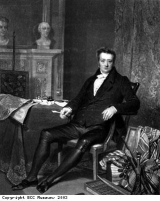Thomas Clarkson in Bristol
Thomas Clarkson was the main campaigner behind the Abolition movement which campaigned to end the slave trade. Clarkson came to Bristol in 1787 to look into the conditions of the slave trade. He wanted to find out more about the slaving voyages to use as further evidence against the trade in his fight for its abolition. Clarkson wanted to know about the state of trade with Africa, including the trade in timber and ivory, as well as the slave trade. He also wanted to find out about the conditions on the slaving voyages for the slaves and crew.
Through these enquiries, Clarkson learnt about the appalling conditions suffered by seamen as well as by the enslaved Africans. Slave ship captains had a reputation for cruelty. Clarkson heard about sailors punished for minor offences with severe beatings, as well as about suspected murders and cruel punishments. He also realised, through looking through the shipping records, that the death rate amongst the crew members was very high. This was not surprising as a ship might spend eight months sailing along the coast of Africa buying slaves before crossing the Atlantic Ocean to the Caribbean. During this time off the coast of Africa, the crew caught tropical diseases which they were not used to, such as malaria, which was often fatal.
Clarkson’s findings meant that the Abolition campaign to end the slave trade took on another aim. By abolishing the slave trade, the campaign was also protecting the sailors who manned the ships.
Clarkson was introduced to the landlord of the Seven Stars pub in the docks of Bristol. For a price many pub landlords helped slave captains trick sailors into signing up for a slaving voyage. Most sailors would not want to be part of a slaving voyage because they knew that it would be a long, hard voyage. However, some sailors could be forced through debt, or tricked when drunk, to be part of such a crew. The landlord at the Seven Stars would not help to trick sailors. He acted as guide to Clarkson to show him how the trade operated in the port of Bristol. Clarkson met two ship’s surgeons who had worked on slaving voyages. Alexander Falconbridge had been on four voyages, and James Arnold had been on three and was about to sail on a fourth. Falconbridge wrote of his experiences, and his story was printed in Bonner and Middleton’s Bristol Journal, a newspaper, in 1788. Arnold kept a journal of his voyage on the ship the Ruby, and this was used as evidence by Clarkson against the slave trade.
Clarkson heard so many awful things about the horrors of the slave trade that he felt he could not stay in Bristol any longer without risking his health and happiness. His visit had inspired others who campaigned for the abolition of the slave trade. He left knowing that a local committee would be set up to continue campaigning. In 1823 Clarkson returned to Bristol to speak at the first meeting of the Bristol Auxiliary Anti-Slavery Society. Clarkson is pictured here, at his feet is ‘Clarkson’s Box’, a collection of some of the products from Africa. He used the box to show that African foodstuffs, dye plants and manufactures, such as fine textiles, could replace the trade in slaves, to the benefit of both African and European traders.



